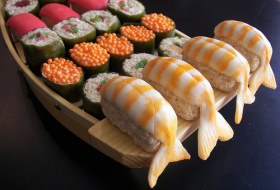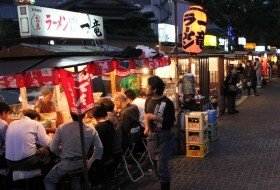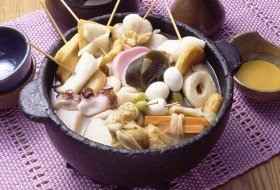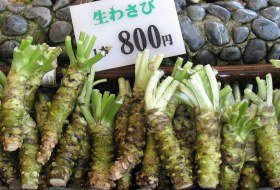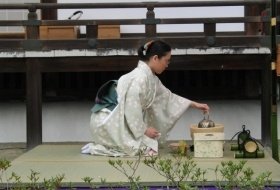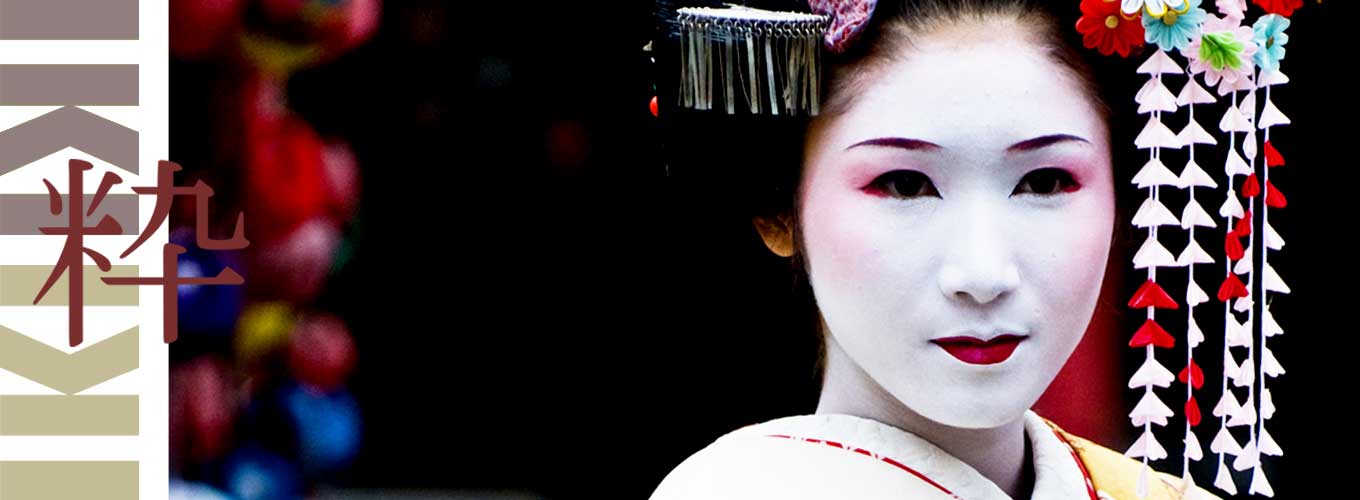
Japanese Cuisine
Whoever says Japan, says sushi. Its popularity has spread so widely that the word sushi is recognised anywhere in the world today. Therefore you might get the impression that Japanese people eat nothing but sushi. In reality sushi is just one of the many Japanese dishes, like sushibars are just one of the many different Japanese restaurants.
Japanese cuisine in general
Japanese cuisine in general: point and eat!
In Japan, the dining experience is not only about the actual food consumed, but also about the presentation, the design, the sheer beauty of what you’re eating. As with everything, Japanese while preparing and presenting a meal, strive for perfection.The quality of the ingredients used is of utmost importance: only ‘the best of the best’ is good enough. A typical Japanese meal consists of a bowl of rice, a bowl of miso soup, pickled vegetables and fish or meat. Fish is mostly eaten raw; in combination with rice, it is called sushi, raw fish on its own is called sashimi.
Traditional Japanese cuisine is considered to be one of the healthiest in the world. Meals are truly a feast for the eyes, the food is healthy, pure and fresh and doesn’t have to be expensive. In a sushibar you can buy a plate of sushi for just ¥100 (0.90 eurocent).
Many restaurants in Japan display plastic or was replicas of their dishes in a window at the entrance.These replicas tend to offer an accurate, visual description of the style and price of meals found inside. For foreigners this is very convenient: you can just point to what you want to order.
Upon entering a restaurant, customers are greeted with the expression “irasshaimase” meaning “welcome, please come in”.
A lunchbox, but then tastier
When you have a long travel day ahead of you, you can purchase a Bentobox which is readily available at convenience stores or railway stations. A Bento is a lunchbox consisting of several compartments. Bento is a single-portion take-out or home-packed meal common in Japanese cuisine. A traditional bento holds rice, sushi or noodles, fish or meat, with pickled and cooked vegetables. It is prepared with a lot of care and attention and the box often looks like a painting. As most Japanese food can be eaten cold, the cuisine lends itself to being packed – often very attractively – in a box for handy consumption anywhere, on the train or whenever you like.
At night, Japanese people usually eat grilled meat or fish, sushi or sashimi, accompanied by a bowl of rice and soup. Ramen is another popular dish which can be eaten as a soup or fried.
Always the best
The food section in a Japanese department store is almost always in the basement and can be an attraction by itself due to the wide variety of Japanese delicacies, sweets, desserts and other consumables on display. In case you don’t feel like going to a restaurant, you can always buy a selection of sushi and yakitori. Every convenience store has a microwave where you can have your food heated up.
Even when you don’t want to buy anything, the food department is always a fun place to roam around. You will be surprised at the excellent quality of the products on sale. Moreover, the service is absolutely great. You will often see friendly store clerks handing over a small portion of food by a toothpick to customers.You can always taste products for free without having to worry that you will be forced into buying anything.
Chopsticks
Japanese people eat with chopsticks. Japanese chopsticks are usually shorter than Chinese chopsticks and taper to a fine point. Chinese chopsticks have rounded sides and end in blunt, flat tips, because Chinese people eat by using a spoon technique, whereas Japanese pick the food with their chopsticks. Even if you are not used to eat with chopsticks, don’t worry. You will get the hang of it with a little practice.
The proper usage of chopsticks is the most important table etiquette in Japan. Chopsticks are never left sticking vertically into rice, as this resembles incense sticks (which are usually placed vertically in sand during offerings to the dead). This may easily offend some Japanese people. Using chopsticks to spear food or to point is also frowned upon and it is considered very bad manners to bite chopsticks.
Everything is available
If you feel like having some European food, many restaurants in big cities in Japan specialise in a foreign cuisine such as Korean, Chinese and Italian cooking. In Tokyo nearly every kitchen in the world is represented. In Tokyo, you can find bars offering Belgian beers and typical Belgian dishes such as ‘steamed mussels in white wine’, ‘chicory and French fries’, etc. that really go well with a blond draft beer.The cafe offers 3 Belgian draft beers and more than 20 kinds of bottled ones, and each beer has its own glass to be served.The funny thing is that you might probably be the one and only Westerner.
Be the chef yoursefl
Have you ever wanted to learn how to make sushi or cook delicious, traditional Japanese food? Why not learn it in Japan itself? In Kyoto we offer a unique cooking workshop. In a single afternoon a Japanese chef will teach you the secrets of Japanese kitchen. And of course, after you have finished cooking, you get to enjoy the lovely food as well.
Are you rather a sweet tooth? Sweeten your time in Japan with a fun sweets making lesson. We also offer a cooking course where you will learn to make Japanese traditional sweets. Back home you will surely impress your friends and families with your new culinary skills.
Wasabi
Wasabi to sushi and sashimi, is like ketchup to fries or mustard to cheese. Wasabi is a water plant that grows naturally along streams beds in the somewhat cooler climate of mountain river valleys in Japan. The Matsumoto area is renowned for its wasabi farms.
In some high-end restaurants, the paste is prepared when the customer orders, and is made using a grater to grate the stem; once the paste is prepared, it loses flavour in 15 minutes if left uncovered. Wasabi is grated with a traditional tool made of dried sharkskin with fine skin on one side and coarse skin on the other. Real wasabi, until grated from the root, isn’t spicy. When grated in a circular, clockwise motion, a paste is formed and hot vapours are released. The ready made “wasabi” consumed in Europe is very often an imposter: a dyed blend of horseradish powder and mustard, two similar roots that are far cheaper. Wasabi tends to be difficult to grow and extremely expensive. As the demand for real wasabi is very high, wasabi is now also grown commercially outside of Japan. Often packages are labeled as wasabi while the ingredients do not actually include any part of the wasabi plant.
Authentic Culinary Japan
Straight from the sea
Far away from the big metropolis, on Noto peninsula, you can stay in a real and authentic fisherman’s house in the fishing village of Wajima. If weather conditions allow, local fishermen will take you fishing in open sea so you can have to experience of catching your own sashimi. You have probably never eaten fish more fresh. Even when weather conditions are not favourable, Wajimi is definitely worth visiting. The town has a nice atmosphere due its small houses, fishing boats and drying nets. Don’t miss the Morning Market, where local people flock together, to sell their goods.
Fish auction Tokyo
In Tokyo you can visit world’s largest wholesale fish and seafood market. Already early in the morning this buzzing commercial market is in full swing with electric carts whizzing around. The auctions start around 5:20 a.m.Prior to the auction the tuna buyers test and assess the frozen tuna to allow them to choose which fish they will bid on and at what price.The tail section of each tuna is cut and a small section is peeled back to expose the flesh of the fish. Buyers, armed with small fish hooks and flash lights, examine the tuna for determining the quality and hence the price they intend to pay. Then the bell rings and the auction starts.The bidding process for buyers is complicated and frantic to witness. It often takes only 15 minutes for all the tuna in the first auction to be sold ! When the auction is over, swing by one of the many the restaurants surrounding the fish market for a delicious sushi breakfast. The local restaurants are typically open from 5:00. This is one of the best places in Tokyo to enjoy fresh seafood.
Stay at a Ryokan
The nights you stay at a traditional hotel (called ryokan or minshuku) or in a temple, you will be served a typical Japanese breakfast. Like lunch and dinner, breakfast is served in many different small bowls. A bowl of rice, small fried fish, a bowl of miso soup, dried seaweed, pickled vegetables, tofu, a piece of omelet or a raw egg and a few umbeboshi plums.
It is very common to dine together. The menu is fixed which gives you the opportunity to taste many dishes, you would otherwise even never have known about. Often it is possible to have dinner served in your room. Do keep in mind that everybody eats at the same time.
Stay at a temple
To really experience Japanese life, spending a night at a Japanese temple is a must-do. Iki Travels can arrange this of course. In addition to that, you can attend a typical Japanese tea ceremony. This can also be arranged. Dinner as well as breakfast are included in the room rate. In a temple, meals are vegetarian.
Tea and sake in Japanese cuisine
In Japan many people drink tea. There are many tea varieties such as basic Hojicha green tea, Genmaicha, Mugicha, etc, but green tea (commonly called Ocha) is the most well-known. Powdered green tea is mainly used for tea ceremonies.
Traditional table and tea ceremony
A Japanse tea ceremony is considered a form of art. Very strict rules apply as a tea ceremony is taken seriously. Zen Buddhism was a primary influence in the development of the Japanese tea ceremony. It is a ceremonial way of preparing and drinking green tea typically in a traditional tearoom with tatami floor. The tearoom is arranged according to the rules of Feng Shui and Zen, to enhance the flow of energy. Drinking tea is done while kneeling on a cushion, to seek harmony and inner peace.
To really experience Japanese culture, a night at a Japanese Buddhist temple is a must-do. Iki travels can organise this for you. Here you can also attend a tea ceremony. When you stay at a tempel, ryokan or minshuku, meals are taken all together. Breakfast as well as dinner is included in the room rate.
Everyone his own bottle
Besides tea, Japanese also drink sake beer and whisky. Sake is a Japanese alcoholic drink made of fermented rice and water. In Japanese, the word ‘sake‘ also means alcoholic beverages in general. Depending on the brewer’s method and recipe, Japanese sake can be dry or sweet, have a very subtle flavour or a particularly strong one.
In most convenience stores you will only find regular sake. In local bars and restaurants you might see shelves full of sake bottles with Japanese writing on them. These are the sake bottles of regular customers. ‘Bottle Keep’ is a system at Japanese bars that allows customers to purchase a bottle and store it at the establishment if they can’t finish it. Likewise a customer can always drink sake from his own personal bottle. Bottles are usually kept in plain view with customer’s names written on them.
A visit to a sake brewery
Iki travels can organise a visit to a sake brewery, either in Kobe or in Tokyo. You’ll get a guided tour of their facilities, which often ends in sampling of the sake. In Kobe you can find world’s most expensive beef. The meat is a delicacy, valued for its flavour, tenderness, and fatty, well-marbled texture.Farmers give their cows beer to drink and even give their cows the occasional massage to perfect the taste of the meat.
Kit Kat tastes
Kit Kat stores and flavours
Did you know that Kit Kat is extremely popular in Japan? In Japan every big city has its own Kit Kat flavour. Kit Kat is easily the most popular chocolate brand in Japan, for the simple reason that the name sounds like ‘kitto katsu’, which is a common Japanese expression of ‘good luc’k. More than 300 limited-edition seasonal and regional flavours of Kit Kats have been produced in Japan since 2000. Kit Kat is so popular in Japan that there are shops that sell nothing else but Kit Kat and Tokyo even has a Kit Kat Museum.
Kit Kat flavours :
|
Kit Kat |
Strawberry |
Kit Kat |
Raspberry Passionfruit |
Kit Kat |
Red beans |
|
Kit Kat |
Strawberry cheesecake |
Kit Kat |
Fruit Parfait |
Kit Kat |
Red Chili |
|
Kit Kat |
Apple cider vinegar |
Kit Kat |
Ginger Ale |
Kit Kat |
Royal Milktea |
|
Kit Kat |
Bakeable custard |
Kit Kat |
Golden Citrus |
Kit Kat |
Raisin |
|
Kit Kat |
Banana |
Kit Kat |
Green beans |
Kit Kat |
Sake |
|
Kit Kat |
Blueberry |
Kit Kat |
Vegetable juice |
Kit Kat |
Sakura |
|
Kit Kat |
Butter |
Kit Kat |
Hojicha |
Kit Kat |
Shinshu apple |
|
Kit Kat |
Brown sugar syrup |
Kit Kat |
Cinnamon cookie |
Kit Kat |
Soymilk |
|
Kit Kat |
Cafe Au Lait |
Kit Kat |
Caramel Macchiato |
Kit Kat |
Soy sauce |
|
Kit Kat |
Cappuccino |
Kit Kat |
Chestnut |
Kit Kat |
Salt Stone |
|
Kit Kat |
Chocolate pudding |
Kit Kat |
Cherry blossom |
Kit Kat |
Sublime Ruby |
|
Kit Kat |
Chocobanana |
Kit Kat |
Cherry Blossom |
Kit Kat |
Triple berry swirl |
|
Kit Kat |
Lemon |
Kit Kat |
Kinako |
Kit Kat |
Wasabi |
|
Kit Kat |
Lemon cheesecake |
Kit Kat |
Kinako Ohagi |
Kit Kat |
Watermelon |
|
Kit Kat |
Coca Cola |
Kit Kat |
Kobe pudding |
Kit Kat |
White Chocolate |
|
Kit Kat |
Coca Cola Lemon |
Kit Kat |
Kuchidoke cacao |
Kit Kat |
Yokohama cheesecake |
|
Kit Kat |
Cranberry Almond |
Kit Kat |
Maple |
Kit Kat |
Yubari Melon |
|
Kit Kat |
Creme Brulee |
Kit Kat |
Matcha |
Kit Kat |
Yuzu |
|
Kit Kat |
Crispy Wafer |
Kit Kat |
Miso soup |
Kit Kat |
Sweet potato |
|
Kit Kat |
Dark |
Kit Kat |
Okinawa Imo |
Kit Kat |
Sweet corn |
|
Kit Kat |
Double Cookie |
Kit Kat |
Passion fruit |
Kit Kat |
Sweet pudding |
|
Kit Kat |
Grapes |
Kit Kat |
Pear |
Kit Kat |
Salt&Caramel |
|
Kit Kat |
Duo |
Kit Kat |
Peanut butter |
||
|
Kit Kat |
Edamame |
Kit Kat |
Pumpkin |
||
|
Kit Kat |
European cheese |
Kit Kat |
Pure |
||
|
Kit Kat |
Exotic Tokyo |
Kit Kat |
Ramune |
||
|
Kit Kat |
Raspberry |
Kit Kat |
Red Velvet |
Popular Japanese dishes
Popular Japanese dishes
Your Japanese food bucket list:
Japanese noodles ramen and/or udon
Ramen is a noodle soup dish, originally imported from China, and is one Japan’s most popular dishes. Ramen are typically categorised according to their soup base, although variations that combine the different bases are not uncommon. The main types of soup are: Shoya (soy sauce), Shio (salt) and Miso (soybean taste). Ramen restaurants can be found on every street corner and each restaurant has its own unique ramen recipe. Ramen noodles are served with fatty slices of roasted or braised pork, spring onions, bean sprouts, a hard boiled egg and seaweed.
Okonomiyaki
Okonomiyaki is a Japanese pancake or pizza. It is pan fried and consists of batter and cabbage. Different toppings and ingredients are added, anything from sliced meat and seafood to wasabi and cheese.
Fried tempura
Tempura consists of seafood, vegetables, mushrooms or meat coated with batter and deep fried.
Omurice
Omurice is an omelette made with fried rice and usually topped with ketchup. “Omu” comes from omelette and “raisu” comes from the Japanese pronunciation of rice.To get the soft egg to perfectly wrap around the fried rice takes patience and requires lots of practice.
Sukiyaki
Sukiyaki is a hotpot soup. It consists of meat (usually thinly sliced beef) which is slowly cooked or simmered at the table, alongside vegetables and other ingredients, in a shallow iron pot in a mixture of soy sauce, sugar and mirin.
Yakiniku
Yakiniku, meaning “grilled meat,” is a Japanese term that, in its broadest sense, refers to grilled meat cuisine. It is very popular in Japan. Today, “yakiniku” commonly refers to a Japanese style of cooking bite-size meat (usually beef or offal) and vegetables on gridirons or griddles over a flame of wood charcoals carbonised by dry distillation or an electric grill. Beef, pork and chicken are also common.
Japanese Yakitori
Yakitori are skewered grilled chicken pieces seasoned with salt or sauce.They are readily available in Japan and served in izakaya’s (Japanse bars), or served during events and festivals. There are other varieties as well made with pork, beef or vegetables.
Unaju
Unaju is also called unadon. It consists of a donburi type large bowl filled with steamed white rice, and topped with fillets of eel (unagi) grilled in a style known as kabayaki, similar to teriyaki.The fillets are glazed with a sweetened soy-based sauce, called tare and caramelised, preferably over charcoal fire. The dish is presented in a square bentobox with a layer of steamed rice and on top the grilled eel. Vegetables are served separately.
Mochi
Mochi is Japanese rice cake made of mochigome, a short-grain japonica glutinous rice. The rice is first soaked, then steamed or boiled, pounded into paste and molded into the desired shape.In Japan it is traditionally made in a ceremony called mochitsuki.
Dango
Dango is a Japanese dumpling and sweet made from mochiko (rice flour). It is often served with green tea. Three to five dango are often served on a skewer and they are often eaten with honey or another sauce.They sometimes come in three different colours, and, although they are coloured with natural dyes, they tastes the same.
Tonkatsu
Tonkatsu is a Japanese dish which consists of a breaded, deep-fried pork cutlet. As a single dish, it is used as a sandwich filling or served in combination with curry and rice.
Donburi
Donburi refers to a bowl of plain, cooked rice with some other food on top of it. Some of the most popular varieties are gyudon (stewed beef), tendon (tempura), oyakodon (chicken and egg), etc.
Gyudon
Gyūdon, literally ‘beef bowl’, is a Japanese dish consisting of a bowl of rice topped with beef and onion simmered in a mildly sweet sauce.Japan has many chainstores that sell gyudon.
Onigiri
Onigiri are rice balls, made of cooked rice and are typically wrapped in nori seaweed. They are usually lightly seasoned with salt and often contain a filling, such as umeboshi (pickled Japanese plum), okaka (dried bonito shavings and konbu) or salmon.
Yakisoba
Yakisoba are fried noodles in oyster sauce, often served with vegetables, meat, fish or seafood. The noodles are often fried on a teppanyaki plate.
Miso soup
Soup made with miso (bean paste) suspended in dashi, usually containing two or three types of solid ingredients, such as seaweed, vegetables or tofu. The soup is served along fish and rice dishes.
Gyoza
Gyoza is an authentic Japanese dumpling with a vegetable or a meat (or a combination of both) filling, flavoured with a little soy sauce.
Taiyaki
Taiyaki is a Japanese fish-shaped cake. The most common filling is red bean paste that is made from sweetened azuki beans.
Kare Raisu
Introduced from the UK in the late 19th century, Japanese ‘curry rice’ is one of the most popular dishes in Japan. It is even more popular than sushi and miso soup.
For our tours to Japan, go to:
All our tours can be modified and combined.
